Study on Comprehensive Assessment of Environmental Impact of Air Pollution
Abstract
1. Introduction
2. Overview
3. The Study Area and Research Methods
3.1. The Study Area
3.2. Research Methods
3.2.1. The Pollution Sources and The Pollution Stress
3.2.2. The Evaluation End Point
4. Results
4.1. Environmental Impact Assessment Results of the Haixi District
4.2. Results of the Environmental Impact Assessment on Different Energy Consumption Departments
4.3. Environmental Impact Assessment Results of Different Cities
4.4. Summary
5. Discussion
6. Conclusions
Author Contributions
Funding
Institutional Review Board Statement
Informed Consent Statement
Data Availability Statement
Acknowledgments
Conflicts of Interest
References
- China Legal Press. Environmental Protection Law of the People’s Republic of China; China Legal Press: Beijing, China, 2015; ISBN 9787509360446. [Google Scholar]
- Wilson, S.R.; Madronich, S.; Longstreth, J.D.; Solomon, K.R. Interactive Effects of Changing Stratospheric Ozone and Climate on Tropospheric Composition and Air Quality, and the Consequences for Human and Ecosystem Health. Photochem. Photobiol. Sci. 2019, 18, 775–803. [Google Scholar] [CrossRef] [PubMed]
- Wang, S.S.; Xu, J.H.; Qiu, C.R. Bounds Testing for Energy Consumption and Environmental Pollution. China Popul. Resour. Environ. 2010, 20, 69–73. [Google Scholar] [CrossRef]
- Zhou, Q.; Yabar, H.; Mizunoya, T.; Higano, Y. Evaluation of Integrated Air Pollution and Climate Change Policies: Case Study in the Thermal Power Sector in Chongqing City, China. Sustainability 2017, 9, 1741. [Google Scholar] [CrossRef]
- Bell, J.N.B.; Power, S.A.; Jarraud, N.; Agrawal, M.; Davies, C. The Effects of Air Pollution on Urban Ecosystems and Agriculture. Int. J. Sustain. Dev. World Ecol. 2011, 18, 226–235. [Google Scholar] [CrossRef]
- Singh, N.; Singh, S.; Mall, R.K. Chapter 17—Urban Ecology and Human Health: Implications of Urban Heat Island, Air Pollution and Climate Change Nexus. In Urban Ecology; Verma, P., Singh, P., Singh, R., Raghubanshi, A.S., Eds.; Elsevier: Amsterdam, The Netherlands, 2020; pp. 317–334. [Google Scholar]
- Agren, G.I.; Bosatta, E.; Magill, A.H. Combining Theory and Experiment to Understand Effects of Inorganic Nitrogen on Litter Decomposition. Oecologia 2011, 128, 94–98. [Google Scholar] [CrossRef]
- Liu, W.Z.; Wang, X.Y.; Fan, Y.B. A review of atmospheric nitrogen deposition and its estimated contributions to nitrogen input of waters. Environ. Pollut. Control 2014, 36, 88–93, 101. [Google Scholar] [CrossRef]
- Wang, J.F.; Li, J.Y.; Ye, J.H.; Zhao, J.; Wu, Y.Z.; Hu, J.L.; Liu, D.T.; Nie, D.Y.; Shen, F.Z.; Huang, X.P.; et al. Fast sulfate formation from oxidation of SO2 by NO2 and HONO observed in Beijing haze. Nat. Commun. 2020, 11, 1–7. [Google Scholar] [CrossRef]
- Dickerson, R.R.; Li, C.; Li, Z.; Marufu, L.T.; Gong, F. Aircraft Observations of Dust and Pollutants over northeast China: Insight into the Meteorological Mechanisms of Long-Range Transport. J. Geophys. Res. Atmos. 2007, 112, 177–180. [Google Scholar] [CrossRef]
- Fioletov, V.E.; Mclinden, C.A.; Krotkov, N.; Yang, K.; Loyola, D.G.; Valks, P. Application of OMI, SCIAMACHY, and GOME-2 Satellite SO2 Retrievals for Detection of Large Emission Sources. J. Geophys. Res. Atmos. 2013, 118, 11399–11418. [Google Scholar] [CrossRef]
- Kajino, M.; Ueda, H.; Sato, K.; Sakurai, T. Spatial Distribution of the Source-Receptor Relationship of Sulfur in Northeast Asia. Atmos. Chem. Phys. 2011, 6475–6491. [Google Scholar] [CrossRef]
- Sivarethinamohan, R.; Sujatha, S.; Priya, S.; Sankaran; Gafoor, A.; Rahman, Z. Impact of Air Pollution in Health and Socio-Economic Aspects: Review on Future Approach. Mater. Today Proc. 2020. [Google Scholar] [CrossRef]
- Gulia, S.; Nagendra, S.M.S.; Khare, M.; Khanna, I. Urban Air Quality Management—A Review. Atmos. Pollut. Res. 2015, 6, 286–304. [Google Scholar] [CrossRef]
- Wang, J.N. Environmental Costs: Revive China’s Green GDP Programme. Nature 2016, 534, 37. [Google Scholar] [CrossRef]
- Xia, Y. Economic Analysis on the Contribution of Mobile-Source to the Air Pollution Index: The Case of Dalian. J. Wuhan Inst. Technol. 2010, 9, 45–48. [Google Scholar] [CrossRef]
- U.S. Environmental Protection Agency. Introduction to Emission Inventories; U.S. Environmental Protection Agency: Washington, DC, USA, 2005; p. 442.
- Wang, G.; Bai, S.; Oglen, J. Identifying Cotributionms of On-Road Motor Vehicles to Urban Air Pollution Using INAVEL Demand Model Data. Transp. Res. Part D Transp. Environ. 2009, 14, 168–179. [Google Scholar] [CrossRef]
- Claggett, M.; Houk, J. Comparing MOBILE 6.2 and EMFAC 2007 Emission Factors. Transp. Res. Rec. J. Transp. Res. Board 2008, 2058, 51–57. [Google Scholar] [CrossRef]
- Guo, H.; Zhang, Q.Y.; Shi, Y.; Wang, D.H. Evaluation of the International Vehicle Emission (IVE) Model with On-Road Remote Sensing Measurements. J. Environ. Sci. 2007, 19, 818–826. [Google Scholar] [CrossRef]
- Ning, Y.; Li, H. Estimation of Major Air Pollutants Emissions from Mobile Sources in China. J. Environ. Eng. 2016, 10, 4435–4444. [Google Scholar] [CrossRef]
- Wei, B.; Li, H.; Du, J.; Liang, Z.; Wang, Y. Study on VOCs Emission and Ozone Generation Potential of Mobile Source on National Trunk Highway. Environ. Sci. China 2019, 39, 4043–4053. [Google Scholar] [CrossRef]
- Zhang, J.; Xian, Y.; Chen, B. Study on the Emission Inventory from Mobile Source in Nanchang. Acta Sci. Circumst. 2017, 37, 2449–2458. [Google Scholar] [CrossRef]
- Men, X.; Xie, Y. Study on Emission Characteristics of Mobile Sources and Pollution Control Countermeasures in Anyang City. Resour. Conserv. Environ. Prot. 2020, 222, 118. [Google Scholar] [CrossRef]
- Liu, X.; Chen, Q.; Guo, W.; Liu, Z.; Zhu, Y. Emission Characteristics and Ozone Formation Potential of VOCS from Mobile Sources: A Pilot Study in Lanzhou. Acta Sci. Circumst. 2018, 38, 3220–3228. [Google Scholar] [CrossRef]
- Zhang, Z.; Hu, J.; Yu, S.; Lu, B.; Shu, L.; Tian, J. Analysis on Characteristics of Emission Inventory of Mobile Source Pollutants in Nanchong City. Sichuan Environ. 2018. [Google Scholar] [CrossRef]
- Zhang, Y.; Andre, M.; Zhang, X.; Wu, L.; Zhang, Y.; Ma, C.; Zou, C.; Mao, H. Development of a Non-Road Mobile Source Emissions Inventory for Tianjin. Environ. Sci. 2017, 38, 4447–4453. [Google Scholar] [CrossRef]
- Gao, C.; Xu, Q.; Xing, Y.; Na, H. Emission Inventory of Air Pollutants from Road Moving Sources in Low Temperature Areas in Winter. J. North. Univ. Nat. Sci. 2019, 40, 1343–1349. [Google Scholar] [CrossRef]
- Shahbazi, H.; Hossein, V. Impact of Mobile Source Emission Inventory Adjustment on Air Pollution Photochemical Model Performance. Urban Clim. 2020, 32, 100618. [Google Scholar] [CrossRef]
- Deshmukh, P.; Kimbrough, S.; Krabbe, S.; Logan, R.; Baldauf, R. Identifying Air Pollution Source Impacts in Urban Communities Using Mobile Monitoring. Sci. Total Environ. 2020, 715, 136979. [Google Scholar] [CrossRef] [PubMed]
- Qiao, F.; Liu, L.; Yu, L. Quantifying Changes of Mobile Source Air Pollution in Metropolitan Areas Using Vehicle Emission Model MOVES. J. Environ. Sci. Eng. 2014, 336–340. [Google Scholar] [CrossRef]
- Newmark, G. Emissions Inventory Analysis of Mobile Source Air Pollution in Tel Aviv, Israel. Transp. Res. Rec. J. Transp. Res. Board 2001, 1750, 40–48. [Google Scholar] [CrossRef]
- Miller, D.; Actkinson, B.; Padilla, L.; Griffin, R.; RA Alvarez, R. Characterizing Elevated Urban Air Pollutant Spatial Patterns with Mobile Monitoring in Houston, Texas. Environ. Sci. Technol. 2020, 54. [Google Scholar] [CrossRef]
- Polkharel, S.; Bishop, G.; Stedman, D. An On-Road Motor Vehicle Emissions Inventory for Denver: An Efficient Alternative to Modeling. Atmos. Environ. 2002, 36, 5177–5184. [Google Scholar] [CrossRef]
- Zhang, S.; Ke, L.; Qi, Y.; Feng, C.; Zhang, H.; Ye, H. Developmet and Application of Volatile Organic Compound On-Line Emission Monitoring System in Stationary Sources. In Proceedings of the China Environmental and safety monitoring technology seminar in 2016 - the 27th MICONEX scientific instruments benefit the people, Beijing, China, 24 September 2016. [Google Scholar]
- Wei, L.; Zhou, G.; Chen, M.; Lu, F.; Chen, J. Study on Emission Characteristics of VOCs from Four Industries. Guangdong Chem. Ind. 2015, 42, 171–172. [Google Scholar] [CrossRef]
- Lv, C. Application Research of Flue Gas Online Monitoring System Based on DOAS. Ph.D. Thesis, Tianjin University, Tianjin, China, 2013. [Google Scholar]
- Liu, Y.; Chen, B.; Guo, L.; Liu, Y. Emission Inventory and Characteristics of Air Pollutants from Fixed Combustion Point Sources in Nanchang City. J. Environ. Sci. 2017, 37, 1855–1863. [Google Scholar] [CrossRef]
- Zhang, Y. Establishment of Large-Scale Fixed Source Pollutant Emission Inventory in Jiangsu Province and Climate Analysis of Surrounding Source Impact Area of Pollutants in Nanjing. Master’s Thesis, Nanjing University of Information Science & Technology, Nanjing, China, 2014. [Google Scholar]
- Johnson, E. Environmental Impact Assessment Handbook. Int. J. Sustain. Dev. World Ecol. 2011, 18, 36–41. [Google Scholar] [CrossRef]
- Evans, R. The Environmental Impact Statement: A Rhetorical Analysis. Ph.D. Thesis, Texas Tech University, Lubbock, TX, USA, 2013. [Google Scholar]
- Legislative Affairs Office of the State Council of the People’s Republic of China. Law of the People’s Republic of China on Environmental Impact Assessment Office of Research and Development; China Labor and Social Security Bureau Press: Beijing, China, 2019; ISBN 9787516739259.
- Caldwell, L.K. Environmental Impact Analysis (EIA): Origins, Evolution, and Future Directions. Impact Assess. Rev. 1988, 6, 75–83. [Google Scholar] [CrossRef]
- Bond, A.; Pope, J.; Fundingsland, M.; Morrison-Saunders, A.; Retief, F.; Hauptfleisch, M.B.; Bond, A. Explaining the Political Nature of Environmental Impact Assessment (EIA): A Neo-Gramscian Perspective. J. Clean. Prod. 2020, 244, 118694. [Google Scholar] [CrossRef]
- Elvan, D.O. Analysis of Environmental Impact Assessment Practices and Legislation in Turkey. Environ. Sci. Policy 2018, 84, 1–6. [Google Scholar] [CrossRef]
- Huang, Z. Health Impact Assessment in China: Emergence, Progress and Challenges. Environ. Impact Assess. Rev. 2012, 32, 45–49. [Google Scholar] [CrossRef]
- Morgan, R.K. Environmental Impact Assessment: The State of the Art. Impact Assess. Proj. Apprais. 2012, 30, 5–14. [Google Scholar] [CrossRef]
- Sun, W.Q.; Zhou, Y.; Lv, J.X.; Wu, J.Z. Assessment of Multi-Air Emissions: Case of Particulate Matter (dust), SO2, NOx and CO2 from Iron and Steel Industry of China. J. Clean. Prod. 2019, 20, 350–358. [Google Scholar] [CrossRef]
- Jaehun, S.; Jehean, S. Air Emission and Environmental Impact Assessment of Korean Automotive Logistics. J. Clean. Prod. 2017, 159. [Google Scholar] [CrossRef]
- Abduaziz, O.; Cheng, J.K.; Tahar, R.M.; Varma, R. A Hybrid Simulation Model for Green Logistics Assessment in Automotive Industry. Procedia Eng. 2015, 100, 960–969. [Google Scholar] [CrossRef]
- Bicer, Y.; Dincer, I. Life Cycle Environmental Impact Assessments and Comparisons of Alternative Fuels for Clean Vehicles. Resour. Conserv. Recycl. 2018, 132, 141–157. [Google Scholar] [CrossRef]
- Osamah, S.; Ibrahim, D. Comparative Assessment of the Environmental Impacts of Nuclear, Wind and Hydro-Electric Power Plants in Ontario: A Life Cycle Assessment. J. Clean. Prod. 2017, 164, 848–860. [Google Scholar] [CrossRef]
- Atilgan, B.; Azapagic, A. Life Cycle Environmental Impacts of Electricity from Fossil Fuels in Turkey. J. Clean. Prod. 2015, 106, 555–564. [Google Scholar] [CrossRef]
- Jaehun, S.; Jehean, S. The Air Emission Assessment of a South Korean Traditional Building during Its Life Cycle. Build. Environ. 2016, 105, 283–294. [Google Scholar] [CrossRef]
- Tae, S.; Shin, S.; Woo, J.; Roh, S. The Development of Apartment House Life Cycle CO2 Simple Assessment System Using Standard Apartment Houses of South Korea. Renew. Sustain. Energy Rev. 2011, 15, 1454–1467. [Google Scholar] [CrossRef]
- Poorang, P.; Francesco, P.; Farah, E. Life Cycle Environmental Impact Assessment of Contemporary and Traditional Housing in Palestine. Energy Build. 2019, 202, 109333. [Google Scholar] [CrossRef]
- Rasul, M.G.; Arutla, L.K.R. Environmental Impact Assessment of Green Roofs Using Life Cycle Assessment. Energy Rep. 2020, 6, 503–508. [Google Scholar] [CrossRef]
- Maja, Ž.; Rebeka, K.L.; Miroslav, P.; Vesna, Ž.L. Environmental Impact Assessment of Building Envelope Components for Low-Rise Buildings. Energy 2018, 163, 501–512. [Google Scholar] [CrossRef]
- Zhao, W.; Shen, W.; Zou, C.; Li, H. Ecological Risk Assessment on the Development of Key Industries in the Economic Zone on the West Coast of the Straits, China. J. Environ. Sci. 2013, 33, 1186–1194. [Google Scholar]
- Zhao, W. Analysis of Urban Air Quality Change Trend and Influencing Factors in Fujian Province. J. Subtrop. Resour. Environ. 2009, 4, 86–91. [Google Scholar] [CrossRef]
- Zhang, L.; Lin, J.; Qiu, R.; Hu, X.; Zhang, H.; Chen, Q.; Tan, H.; Lin, D.; Wang, J. Trend Analysis and Forecast of PM2.5 in Fuzhou, China Using the ARIMA Model. Ecol. Indic. 2018, 95, 702–710. [Google Scholar] [CrossRef]
- Tang, L.N.; Wang, L.; Li, Q.Y.; Zhao, J.Z. A Framework Designation for the Assessment of Urban Ecological Risks. Int. J. Sustain. Dev. World Ecol. 2018, 25, 387–395. [Google Scholar] [CrossRef]
- He, B.; Mei, S.; Lu, C.; Li, H.; Zhou, Q.; Song, L. Research on the Application of MEIC Emission Inventory in Air Quality Model. China Environ. Sci. 2017, 37, 3658–3668. [Google Scholar] [CrossRef]
- Yin, Y. A Preliminary Study on the Characteristics of Ozone Pollution in the Main Urban Area of Lanzhou City Based on CMAQ Model and MEIC List. Ph.D. Thesis, Lanzhou University, Lanzhou, China, 2019. [Google Scholar]
- Shi, L.Y.; Zhang, M.; Yang, B.; Gao, L.J. Air Pollution-Oriented Ecological Risk Assessment in Xiamen city, China. Int. J. Sustain. Dev. World Ecol. 2018, 25, 1–11. [Google Scholar] [CrossRef]
- Filyushkina, A.; Strange, N.; Löf, M.; Ezebilo, E.E.; Boman, M. Applying the Delphi Method to Assess Impacts of Forest Management on Biodiversity and Habitat Preservation. For. Ecol. Manag. 2018, 409, 179–189. [Google Scholar] [CrossRef]
- Fujian Provincial Bureau of Statistics. Statistical Yearbook of Fujian in 2011. Available online: http://tjj.fujian.gov.cn/tongjinianjian/dz2011/index-cn.htm61 (accessed on 7 May 2020).
- General Office of the State Council. Outline of the 11th Five Year Plan for the National Economic and Social Development of the People’s Republic of China (Summary of Contents on Environmental Protection). Available online: http://www.npc.gov.cn/wxzl/gongbao/2006-03/18/content_5347869.htm (accessed on 5 January 2021).
- Fujian Environmental Protection Department. Environmental Quality Bulletin of Fujian Province in 2016. Available online: http://hbt.fujian.gov.cn/zwgk/kjjc/hjzl/qshjzkgb/201706/P020180113663886759014.pdf (accessed on 7 May 2020).
- Xiamen Environmental Protection Bureau. Regulations on Prevention and Control of Motor Vehicle Exhaust Pollution in Xiamen Special Economic Zone. Available online: http://sthjj.xm.gov.cn/zwgk/zcfg/xmsfg/202001/t20200108_2414604.htm (accessed on 7 May 2020).
- China National Bureau of Statistics. China Energy Statistics Yearbook in 2018; China Statistics Press: Beijing, China, 2019; ISBN 9787503787881.
- Yang, S.C.; Shi, L.Y. Public Perception of Smog: A Case Study in Ningbo City, China. J. Air Waste Manag. Assoc. 2016, 67, 219–230. [Google Scholar] [CrossRef]
- Lu, S.W. Research on Air Pollutant Emission Inventory in the Western Taiwan Straits Economic Zone. Master’s Thesis, Xiamen University, Xiamen, China, 2014. [Google Scholar]
- Liu, J.; Mauzerall, D.L.; Chen, Q.; Zhang, Q.; Song, Y.; Peng, W.; Klimont, Z.; Qiu, X.; Zhang, S.; Hu, M.; et al. Air Pollutant Emissions from Chinese Households: A Major and Underappreciated Ambient Pollution Source [Environmental Sciences]. Proc. Natl. Acad Sci. USA 2016, 113, 7756–7761. [Google Scholar] [CrossRef]
- Zhao, Z.Q.; Bai, Z.H.; Winiwarter, W.; Kiesewetter, G.; Heyes, C.; Ma, L. Mitigating Ammonia Emission from Agriculture Reduces PM2.5 Pollution in the Hai River Basin in China. Sci. Total Environ. 2017, 609, 1152–1160. [Google Scholar] [CrossRef]
- Shi, L.Y.; Zhang, M.; Zhang, Y.J.; Yang, B.; Sun, H.P.; Xu, T. Comprehensive Analysis of Nitrogen Deposition in Urban Ecosystem: A Case Study of Xiamen City, China. Sustainability 2018, 10, 4673. [Google Scholar] [CrossRef]
- Sha, H.; Wang, L.; Zhao, Y. Ecological Risk Assessment from the Perspective of Soil Heavy Metal Accumulations in Xiamen City, China. Int. J. Sustain. Dev. World Ecol. 2018, 25, 411–419. [Google Scholar] [CrossRef]
- Central People’s Government of the People’s Republic of China. Fujian Province, China: Clean Energy Power Generation Accounts for More Than Half of the Total Annual Power Generation. Available online: http://www.gov.cn/xinwen/2018-04/11/content_5281534.htm (accessed on 8 March 2020).
- Fujian Provincial People’s Government. Available online: http://www.fujian.gov.cn/xw/fjyw/201812/t20181206_4694055.htm (accessed on 10 April 2020).
- Chen, Q.; Jiang, B.; Liu, Y. Research on the Spatial Excavation of Total Emission Reduction of Industrial Air Pollutants in Fujian Province during the 13th Five Year plan. Channel Sci. 2017, 27–28. [Google Scholar] [CrossRef]
- Fujian Provincial People’s Government. Regulations of Fujian Province on the Prevention and Control of Air Pollution. Available online: http://www.fujian.gov.cn/zc/zxwj/bmwj/201807/t20180717_3447073.htm (accessed on 7 April 2020).
- Simsek, Y.; Sahin, H.; Lorca, Á.; Santika, W.G.; Urmee, T.; Escobar, R. Comparison of Energy Scenario Alternatives for Chile: Towards Low-Carbon Energy Transition by 2030. Energy 2020. [Google Scholar] [CrossRef]
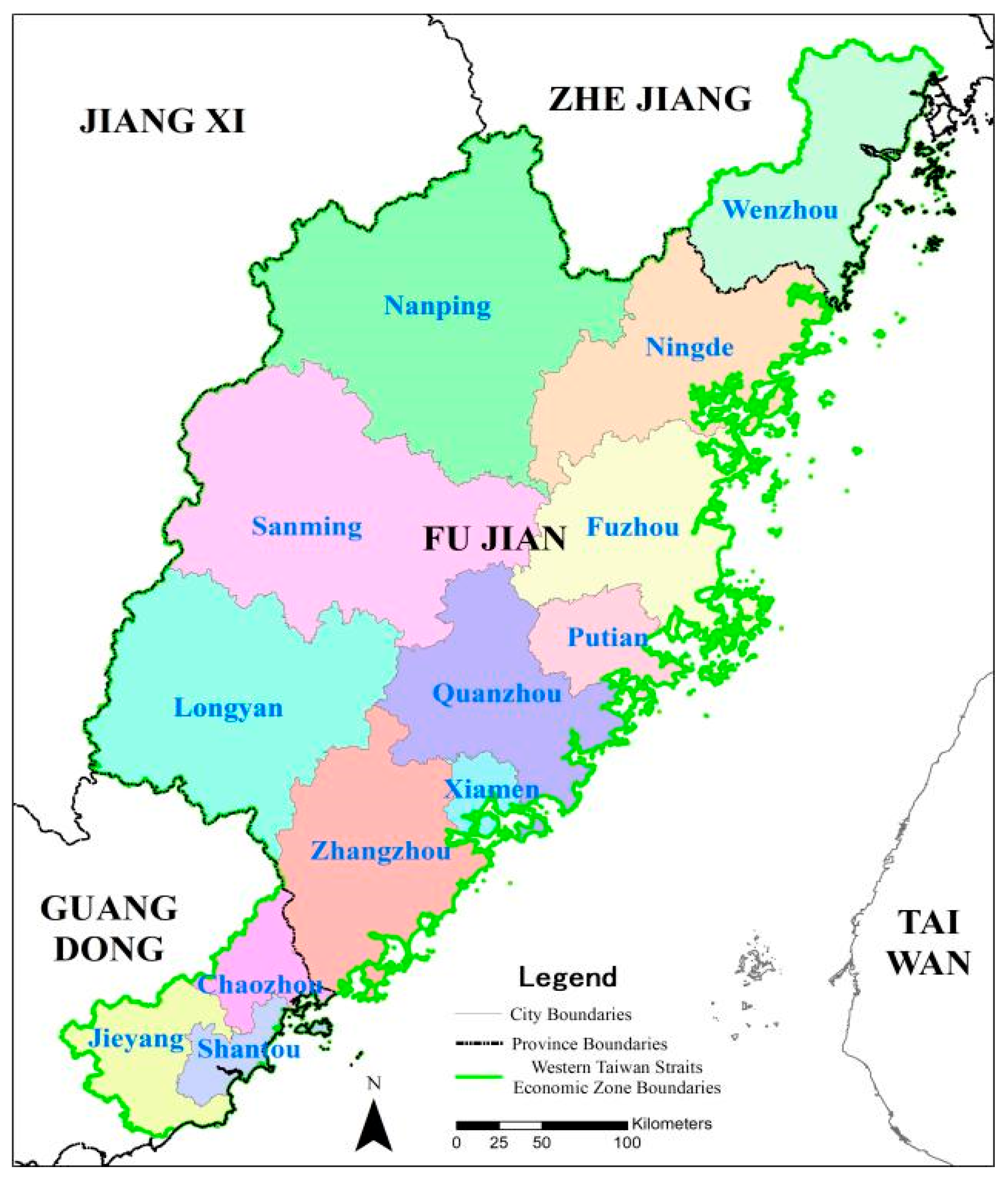

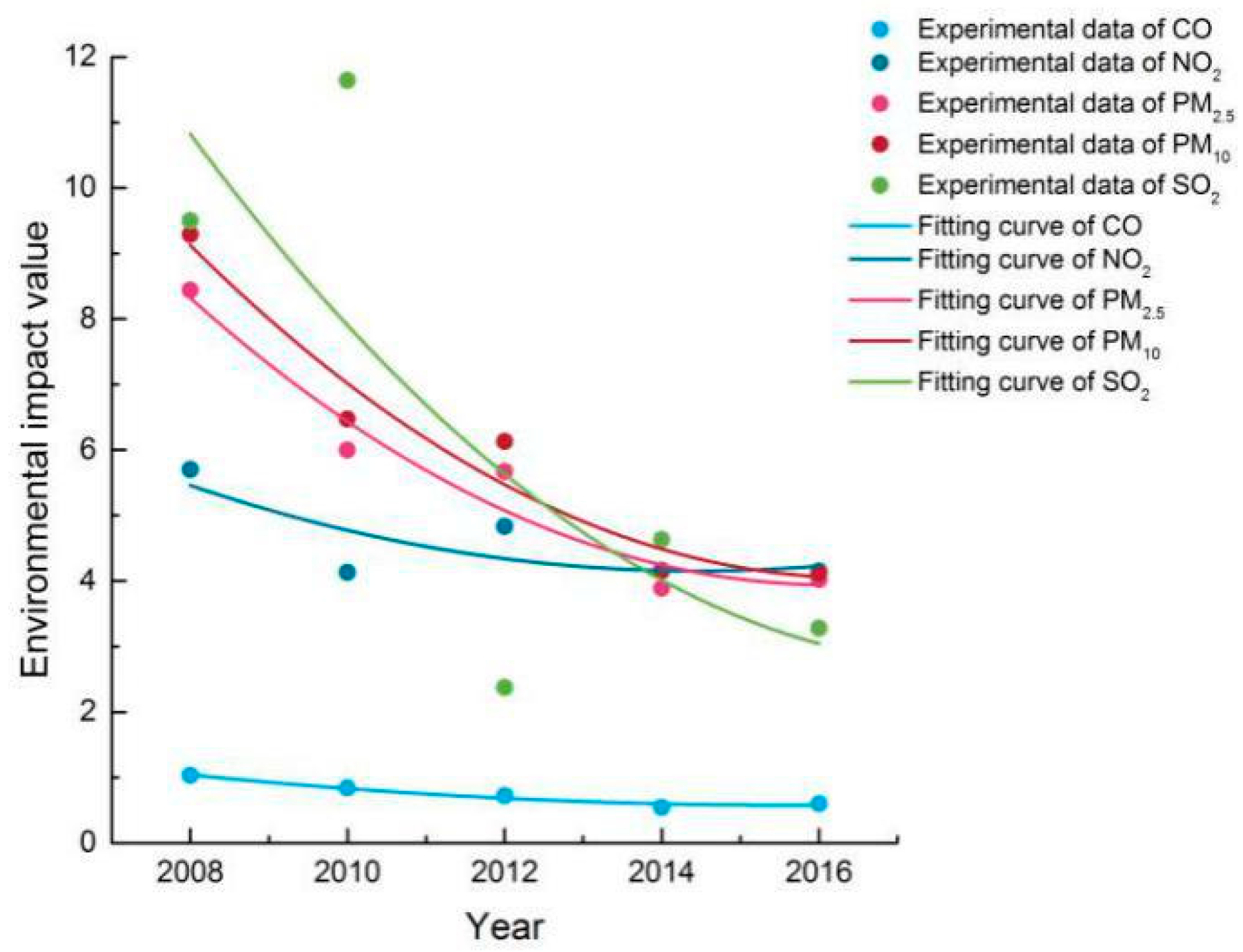
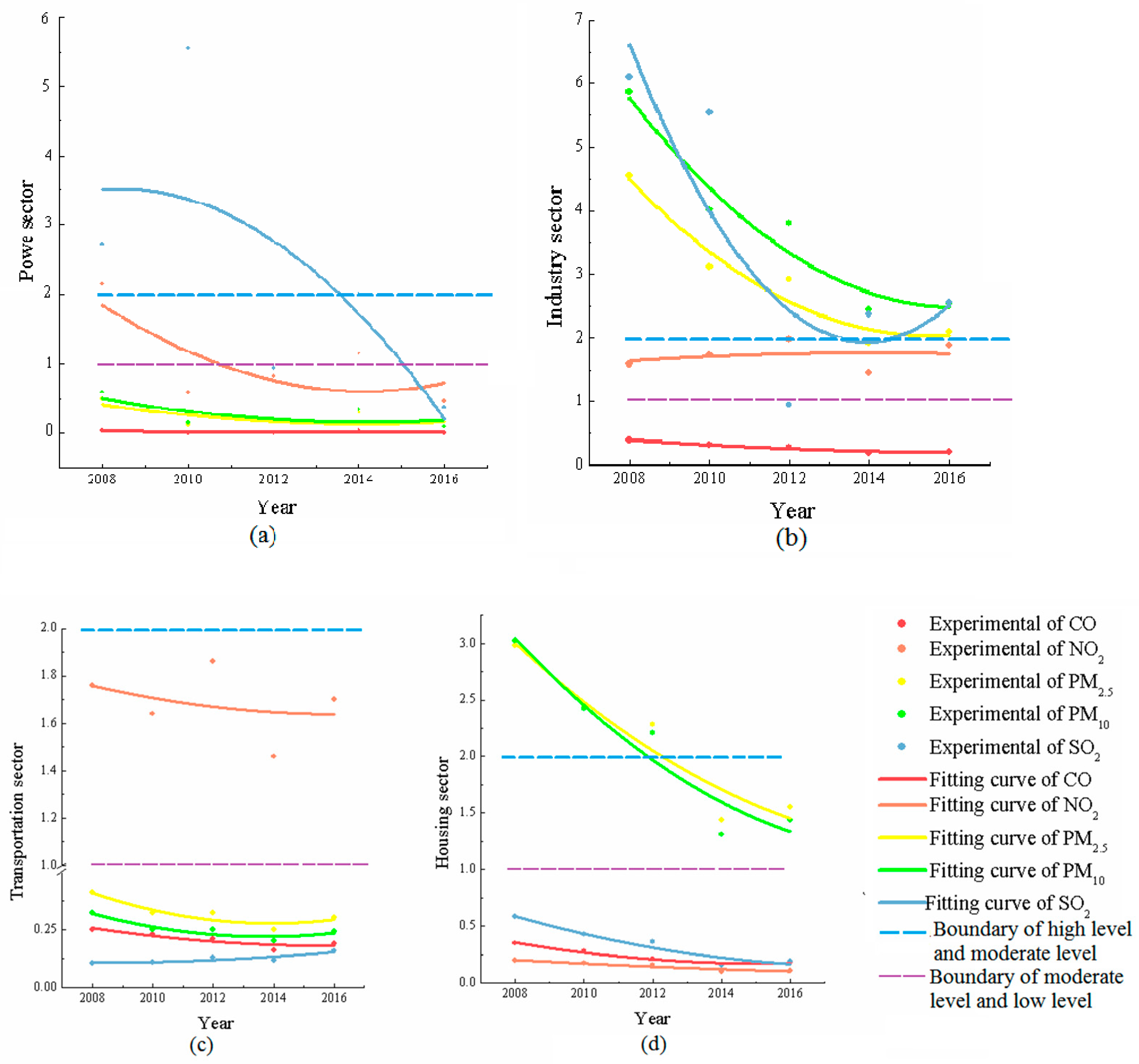
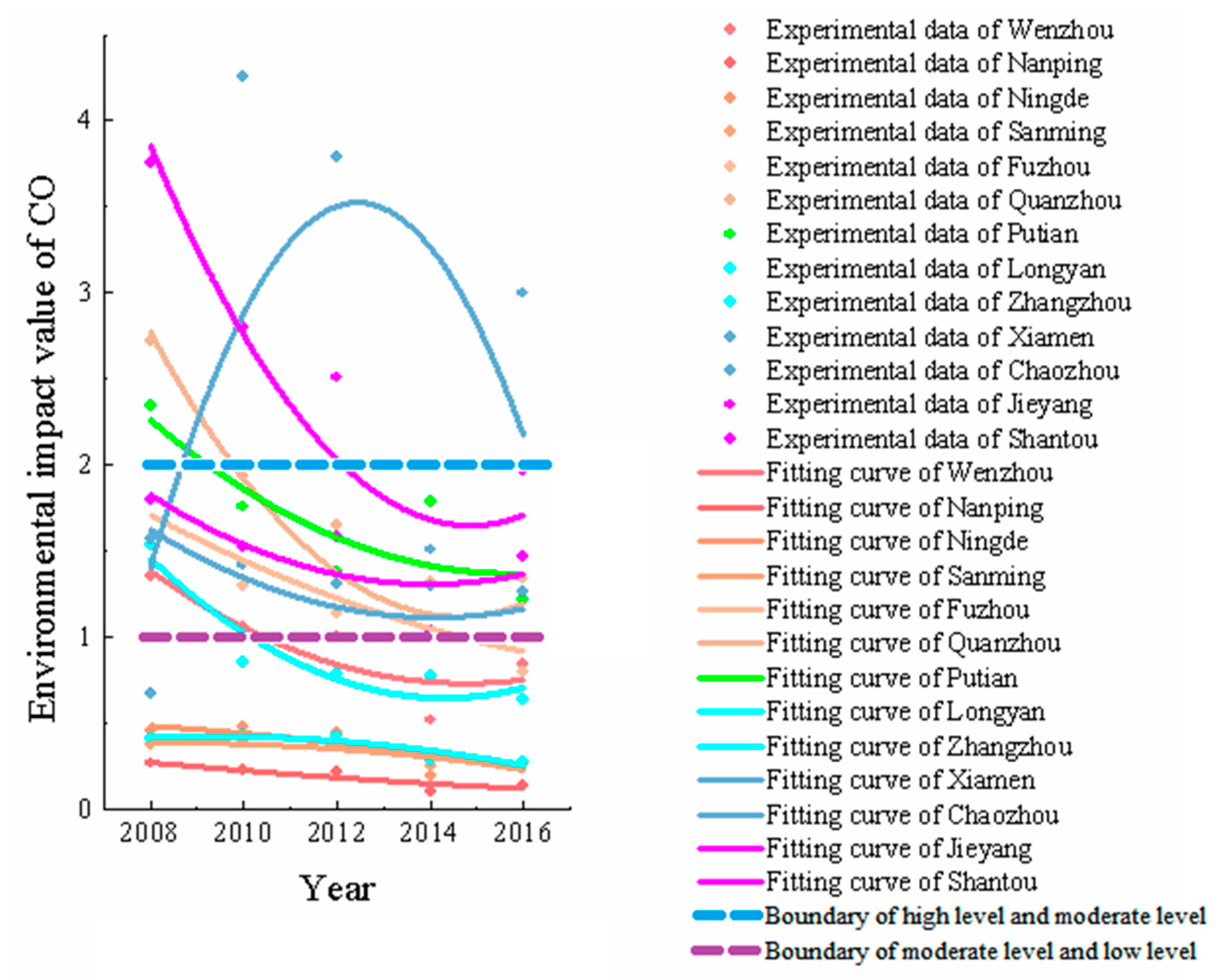

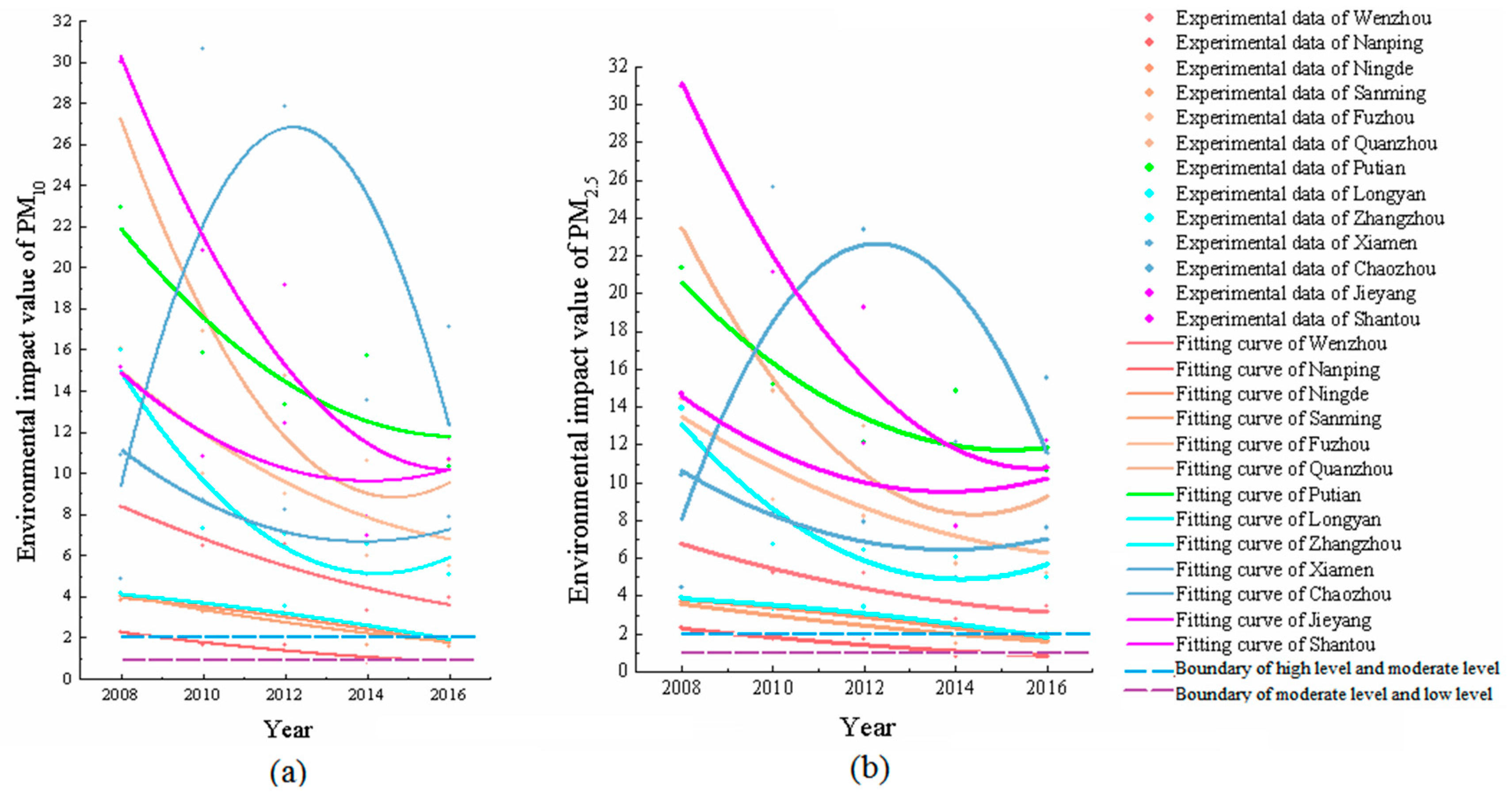
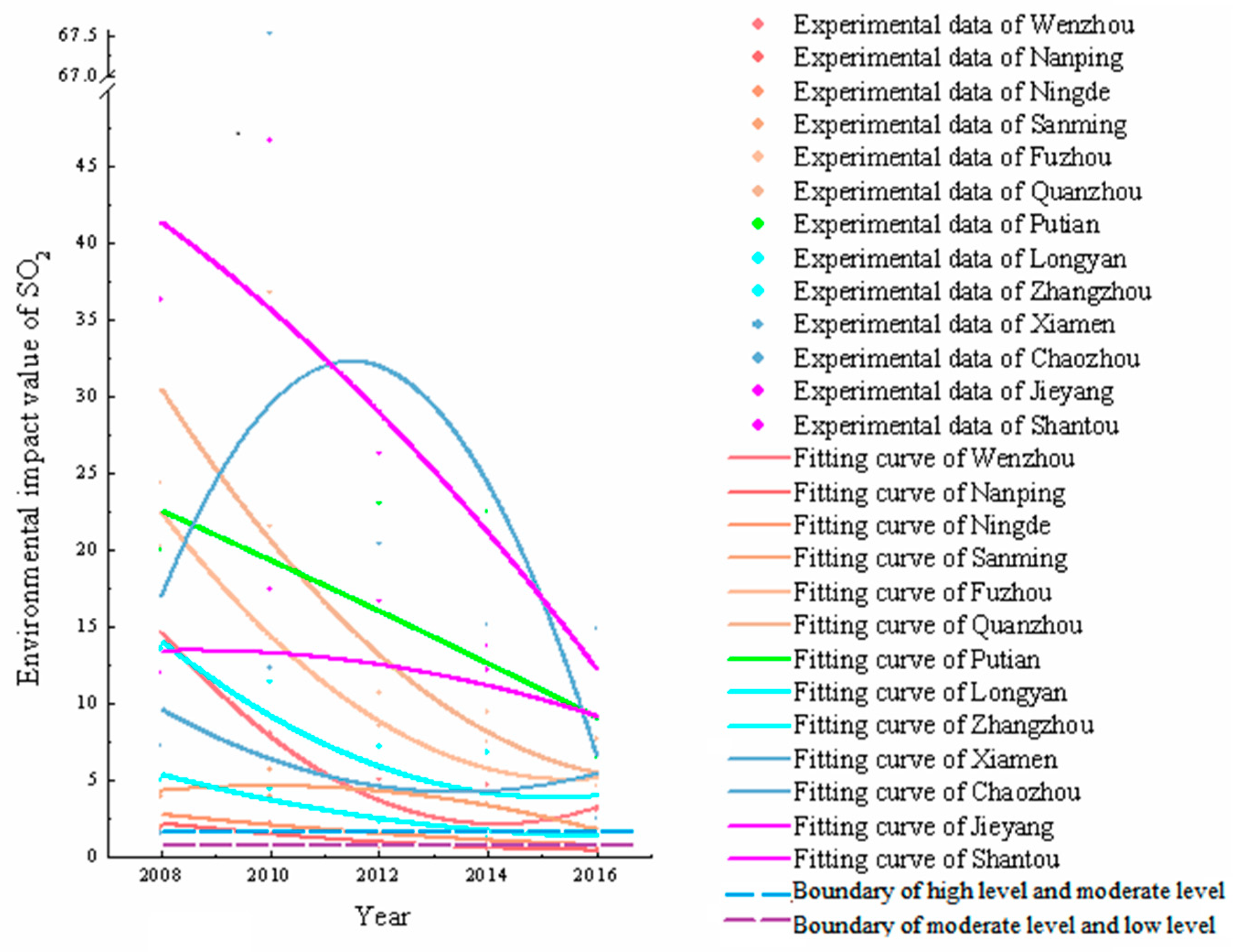
| Ratio | Impact Level | Significance |
|---|---|---|
| V < 1 | Low | Air pollution emissions would not pose a threat to the atmosphere of the study area |
| 1 ≤ V < 2 | Moderate | The air pollution emissions can threaten the air environment of the study area, but it is not significant |
| V ≥ 2 | High | Air pollution emissions pose a high threat to the atmosphere of the study area |
| PM2.5 | PM10 | SO2 | CO | NO2 | |
|---|---|---|---|---|---|
| Wenzhou | 5 | 14 | 2 | 500 | 8 |
| Nanping | 5 | 10 | 4 | 600 | 7 |
| Ningde | 5 | 13 | 2 | 700 | 6 |
| Sanming | 4 | 12 | 5 | 600 | 10 |
| Fuzhou | 4 | 10 | 3 | 400 | 11 |
| Quanzhou | 4 | 11 | 3 | 500 | 10 |
| Putian | 6 | 13 | 5 | 400 | 4 |
| Longyan | 7 | 14 | 6 | 600 | 8 |
| Zhangzhou | 6 | 14 | 4 | 500 | 8 |
| Xiamen | 5 | 12 | 4 | 200 | 7 |
| Chaozhou | 3 | 10 | 7 | 600 | 4 |
| Jieyang | 7 | 13 | 5 | 500 | 6 |
| Shantou | 7 | 8 | 6 | 500 | 7 |
| Haixi District | 5 | 12 | 4 | 508 | 7 |
| PM2.5 | PM10 | SO2 | CO | NO2 | |
|---|---|---|---|---|---|
| Wenzhou | 2552.49 | 3062.98 | 4083.98 | 297,790.03 | 6125.97 |
| Nanping | 6198.899 | 8265.19 | 9504.97 | 702,541.39 | 15,083.98 |
| Ningde | 2734.81 | 3372.93 | 4375.69 | 300,828.71 | 6745.86 |
| Sanming | 5275.14 | 6466.30 | 7657.46 | 578,563.50 | 11,911.60 |
| Fuzhou | 3014.36 | 3889.50 | 4570.17 | 350,055.22 | 6709.39 |
| Quanzhou | 2449.17 | 3081.22 | 3713.26 | 276,519.32 | 5530.39 |
| Putian | 881.25 | 1124.31 | 1367.40 | 109,392.26 | 2309.39 |
| Longyan | 3913.81 | 5032.04 | 6150.28 | 475,248.59 | 10,064.09 |
| Zhangzhou | 2996.13 | 3719.37 | 4752.49 | 361,602.18 | 7438.67 |
| Xiamen | 372.17 | 471.41 | 570.66 | 47,141.08 | 905.60 |
| Chaozhou | 777.90 | 972.38 | 1045.30 | 82,651.93 | 1847.51 |
| Jieyang | 1191.16 | 1574.03 | 1914.36 | 148,895.01 | 3148.07 |
| Shantou | 340.33 | 510.50 | 534.81 | 42,541.43 | 887.29 |
Publisher’s Note: MDPI stays neutral with regard to jurisdictional claims in published maps and institutional affiliations. |
© 2021 by the authors. Licensee MDPI, Basel, Switzerland. This article is an open access article distributed under the terms and conditions of the Creative Commons Attribution (CC BY) license (http://creativecommons.org/licenses/by/4.0/).
Share and Cite
Zhang, M.; Shi, L.; Ma, X.; Zhao, Y.; Gao, L. Study on Comprehensive Assessment of Environmental Impact of Air Pollution. Sustainability 2021, 13, 476. https://doi.org/10.3390/su13020476
Zhang M, Shi L, Ma X, Zhao Y, Gao L. Study on Comprehensive Assessment of Environmental Impact of Air Pollution. Sustainability. 2021; 13(2):476. https://doi.org/10.3390/su13020476
Chicago/Turabian StyleZhang, Miao, Longyu Shi, Xiaofei Ma, Yang Zhao, and Lijie Gao. 2021. "Study on Comprehensive Assessment of Environmental Impact of Air Pollution" Sustainability 13, no. 2: 476. https://doi.org/10.3390/su13020476
APA StyleZhang, M., Shi, L., Ma, X., Zhao, Y., & Gao, L. (2021). Study on Comprehensive Assessment of Environmental Impact of Air Pollution. Sustainability, 13(2), 476. https://doi.org/10.3390/su13020476




